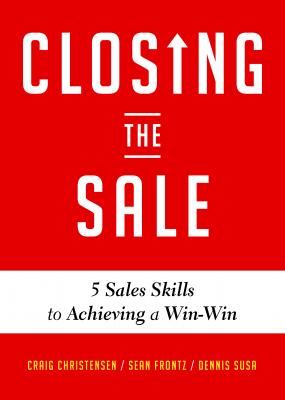Closing the Sale. Craig Christensen
Чтение книги онлайн.
Читать онлайн книгу Closing the Sale - Craig Christensen страница 2
 multiple sources has dramatically changed the buyer/seller relationship. It has empowered buyers—and has diminished their reliance on sellers as information providers. This influences how they interact with sellers and has changed their expectations of what sellers should provide. Buyers now expect that sellers shift from a traditional sales role to a trusted advisor, moving away from creating dependency to creating value and fostering relationships of trust.
multiple sources has dramatically changed the buyer/seller relationship. It has empowered buyers—and has diminished their reliance on sellers as information providers. This influences how they interact with sellers and has changed their expectations of what sellers should provide. Buyers now expect that sellers shift from a traditional sales role to a trusted advisor, moving away from creating dependency to creating value and fostering relationships of trust.
Increasing your own success by focusing on the success of others isn’t about wishful thinking or taking an “enlightened approach” to selling, but rather a practical reality based on the necessity of creating relationships of trust and mutual value.
Our entire Sales Performance Practice has been built on the application of this extraordinary principle.
Paradox of Success:The more you focus on creating success for your clients, the more successful you will be.
CLOSING THE SALE
And this principle couldn’t be more relevant than during the “closing” in sales. Countless salespeople have been trained to think of “closing” as an event—a single meeting, presentation, or point in time where you either win or you lose. In this book, we will share a different perspective on closing and offer a new way of thinking about your role as a sales professional. We’ll also share five essential skills you can learn and master to ensure that your clients (and you) succeed.
We believe that a tangible measurement of progress is essential. That is why this book is not a book about theory; it is about practical application and tools you can use immediately to gauge your success—in other words, your closing ratio or Win Rate. Although Win Rate may be defined very differently from company to company, we measure Win Rate by dividing the number of wins by the number of opportunities pursued.
The question for you is What would you be willing do in the coming days and weeks to improve it? Read on for the 5 Skills and tools you can apply.
It’s our belief that if you focus on creating success for your clients and commit to the practice of the mindset and skillset presented in the pages that follow, you will improve your ability to close sales more frequently and with more consistency and comfort.
Your Role
•••
WHAT YOU WILL LEARN IN THIS CHAPTER
Closing is a process, not an event.
The Closing Zone is a series of incremental decisions the client makes to get to a final business decision.
Your role is to influence good decisions to achieve win-win outcomes.
What Does Closing Mean?
Closing means different things to different people. What does it mean to you? For some, closing is a technique, a collection of things you do and say to push a client into signing on the dotted line. For others, it’s a verb commanding you to do something to someone rather than with someone. And for others, the word signifies the onset of a negotiation.
Most commonly, people tend to think of closing as an event, or the moment when the client formally commits to making a final business decision—first verbally and then on paper.
Instead, we’d suggest that closing is the process of successful decision making that has happened long before the day the contract is awarded or inked. And often a successful “close” is the direct result of how the salesperson has (or hasn’t) added value to the decision-making process along the way.
The Closing Zone
We refer to the final 20 percent of the overall sales cycle as the Closing Zone. It includes a series of incremental decisions the client makes in order to reach the final business decision. When you move into this particular
Your role
CLOSING THE SALE
phase of the sales cycle, there are distinct and recognizable shifts in buyer behavior that let you know you’ve arrived.
Not surprisingly, these shifts in client behavior will likely require you to respond in kind. The way you choose to respond in this critical selling stage will often be the difference between success and failure.
If you think of a sales cycle as you would a courtship, it may give you a clearer sense of what to expect: In the early stage of dating, it’s quite common to meet and interact with many people. The attention is often not exclusive and is typically centered on some objective criteria that might help you prioritize what you find appealing in a partner—appearance, employment status, interests, etc.—and assist you in narrowing the field of potential partners from many to a few.
By contrast, in the later stages of courtship, the emphasis shifts from basic attributes (requirements) to more subjective criteria, to ensure that the right partner is selected and is capable of upholding the commitments made—serving to narrow the few to “the one.”
Closing is a process of successful decision making.
CLOSING THE SALE
When prospective clients enter the Closing Zone, you’ll start to see some telltale signs that they have done so:
Dialogue moves from considering as many options as possible to actively focusing on a few options.
The number of potential suppliers will go from many to a few.
Vendor credibility, capability, and compatibility take on greater importance than the solution attributes and requirements.
“Facts” rapidly become secondary to “beliefs.”
Client objections and concerns are raised with more frequency and emotion.
Often salespeople don’t understand these subtle decision-making shifts. They